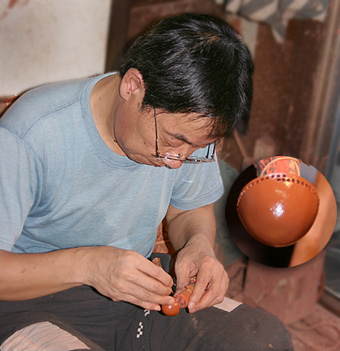How to Choose a Teapot
There are many different kinds of tea in the world. Choosing the right teapot for a particular type of tea is an important process and one which can have a great effect on the overall taste and drinking experience. Japanese teapots are expressly made for green tea unless otherwise stated, even though they can also be used to brew other types of tea.
Teapot Materials
Porcelain teapots are said to heighten the fragrance of the tea, and the smooth, glazed surface leaves no traces of taste or smell, thus providing a neutral zone for the taste of the tea to be fully appreciated. Other ceramic teapots such as those made of stoneware have water-absorbing properties and are said to absorb astringency. It is assumed that “catechin,” which causes astringency in tea, attaches itself to the uneven surface inside the teapot. The iron compound on the teapot surface is also assumed to remove astringency from the tea. Ceramic teapots retain the ideal temperature for brewing, whereas glass teapots cool down very quickly.
Clay Type
Unblended clay is referred to as either Tokoname Shudei or Honshudei. Shudei means vermillion and refers to the color of the clay after firing. Honshudei turns a paler color than blended vermillion clay. As “hon” can be translated as “real,” many craftsmen are reluctant to use the term as it implies that other clays are inferior. This is definitely not the case. Blending clay is very common in Tokoname and is regarded as a means of artistic expression.
While it is generally accepted that clay has the effect of absorbing astringency, most craftsmen do not recognize the efficiency of one particular clay over another in this respect. In Japan, it is generally considered that there are other overriding factors that come into play when brewing a good cup of tea, such as water quality, brewing temperature, and steeping times.
Teapot Size
The indicated teapot volume is the full capacity, measured by filling water up to the brim or underneath the lid. You can choose the right size of teapot according to your needs by considering the size of your cups and the number of cups you wish to brew at one time. When you choose a flat teapot, it is practical to fill it up to about 80% of the capacity. Small teapots are normally used to brew high grade sencha and gyokuro. Big pots are used for brewing many cups of tea or teas such as houjicha, bancha, and genmai-cha (e.g., Somayaki and Bizen teapots are popular for these teas).
Filters
Japanese teapots come equipped with a variety of ceramic filters.

- 1. Sasame
- 2. Cera-mesh
- 3. Debeso (half-ball shape)
- 4. Do-ake (holes made directly on the teapot body)
#1 Sasame and #2 Cera-mesh are the most common types of ceramic filter. They have different names but are more or less the same. The regularity of the holes and the wide surface assure a good flow of tea without undue clogging. These types are suitable for all kinds of tea including fukamushi. When brewing fukamushi, some small leaves may pass through the filter. Most tea drinkers are comfortable with this as the amount is minimal and the leaves have nutritional value. If you prefer not to have any leaf residue, then a fine metal filter is probably a better choice.
#3 Debeso: This is a half-ball shaped filter with hand-punched holes. The number and size of the holes depend on the craftsman. Setsudo, for example, creates filters with 500 and sometimes up to 700 holes. The smaller the holes, the better the pot’s suitability for fukamushi. However, holes that are too small can cause clogging. Generally speaking, because the body of the filter juts out into the pot, the top half remains free of leaves even if the bottom half is covered. If the filter tends to clog easily, try pouring more slowly. Also, if the filter is placed very close to the bottom and submerged in water, it is best to brew a smaller amount using less water in the pot.
#4 Do-ake: Punching holes directly into the teapot’s body may not look as sophisticated, and the holes tend to be larger. Because of the flat shape, clogging may occur more easily. Interestingly, some say tea tastes better when poured through this filter, as one has to pour slowly and steadily to avoid clogging. Opinions vary, but it is also said that Japanese tea is at its best when poured slowly. The Do-ake filter has a number of fans among tea lovers.
Tokoname craftsman Setsudo punching holes onto a ceramic filter.
Making the filter requires complete concentration and a calm state of mind.
The opinions expressed above are meant as general guidelines. This is how I explain the differences in filters to customers in my store. As the scope of Japanese tea is vast and tastes differ from person to person, it is difficult to create an absolute guide. My intention is to provide a reference point for first-time buyers of hand-crafted teapots.
Please also refer to the link below for a general overview:
https://www.artisticnippon.com/japaneseteapots/kyusu.html
